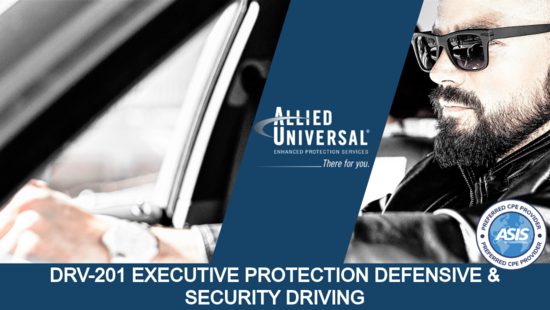
EXECUTIVE PROTECTION DEFENSIVE & SECURITY DRIVING (DRV-201)
Outline
EXECUTIVE PROTECTION DEFENSIVE AND SECURITY DRIVING
This dynamic one-day driving program is fully customized for professional security drivers, executive drivers, and protection teams seeking to build specialized skills and accurately determine the proficiency of each team member. This training program certifies every student’s individual skill level in relation to the maximum capabilities of the vehicle.
This course focuses on vehicle dynamics, threat avoidance, collision avoidance, and response to emergency scenarios. Training is conducted by the Training Operations Group in partnership with Vehicle Dynamics Institute, (VDI).
WHO SHOULD ATTEND?
This course is designed for security professionals of all skill levels. Coaching and exercises are gradually adapted to create new skills based on the experience of each individual, from the very basic to the most advanced, measuring each step systematically.
TRAINING TIMELINE
Classroom Instruction (2 hrs.)
Understanding “Driving” From A Technical Standpoint:
Knowledge and skill exist in different parts of the brain, and making sure you understand a skill’s dynamics will make it last longer in your brain. Our primary focus is on heuristics, which can only be achieved through experimentation within extreme circumstances. The combination of classroom instruction and immediate application on the track supports both sides of this learning model.
- The classroom portion of this training examines forces which act upon a vehicle (friction, momentum, and centrifugal force), and how acceleration, deceleration, and cornering affect it, as well as what the driver can, or cannot, do to minimize the effects of those forces.
- Topics included in this analysis:
- Time/Distance Relationship
- Lateral Acceleration
- Security Driving 101
- After this discussion, you will understand vehicle and driver performance factors, including mechanical and physical limitations for evasive maneuvers, and what you can do to enhance both.
- Advanced time-distance concepts
- Reaction times
- Common causes for loss of control (understeer and oversteer)
- Vehicle prep list
- Up-armored vehicle considerations
- Vehicle ambush statistics
- Tire nomenclature
Practical Exercises (6 hrs.)- Conducted on the tarmac.
Skill Building Exercises
Slalom Exercise
- Here’s where we put what you’ve learned in the classroom into practice! The slalom exercise creates the necessary heuristics to develop a profound grasp of the time/distance relationship and hand-to-eye coordination. As with all exercises, students will strive to perform above 80% of the vehicle’s handling capability. Difficulty will gradually increase with each successful completion of the exercise, until we reach the limit on your skill level.
Threat Avoidance Maneuver
- This is where skill meets reality; students will be faced with distractions and decision-making challenges from external cues, further settling the heuristics of driving into their subconscious mind and creating the “fine motor skills” that go with it. In this exercise, students will strive to react to a visual threat and avoid an obstacle consistently using above 80% of the vehicle’s capability.
Under and Oversteer
- A no-simulation, no-BS exercise. Many security-related accidents happen during high energy maneuvers, where the driver’s reaction to an initial crisis immediately causes a secondary crisis— usually many times worse than the first— by not being able to control the vehicle as it reaches its limits.
- Energy maneuverability is not intuitive. You can’t assume you know what control is, unless you’ve experienced out-of-control. We only learn at the level where we make mistakes, and this can only be achieved by destroying several sets of tires per course!
Reversing Exercises
Reverse Bailout Maneuvers
- Understanding the dynamics of your vehicle moving in reverse will create the necessary skills to successfully back out of any situation, and get the car facing forward as soon and as safely as possible.
Combined Skills Exercise
· After we’ve created the skillset, we need to put it into perspective so you understand how it will play out in real life.
This exercise has two purposes:
- To evaluate your current skill level at the culmination of the course, and…
- To generate an understanding of how you’ll perform when subjected to high levels of stress (also termed stress inoculation).
REPORTS AND CERTIFICATES
Successful participants will also be awarded a CERTIFICATE OF QUALIFICATION issued by the Training Operations Group and Vehicle Dynamics Institute. Individuals who fail to meet the standards of this program will not be certified by the Training Operations Group.
PROHIBITED ITEMS
The following items must be secured outside the training area:
· All weapons (including firearms, knives, OC spray, impact weapons, etc.)
GENERAL HEALTH AND SAFETY
· Attendees must be in good physical condition and should consult a doctor with any questions regarding their ability to safely participate in defensive tactics training.
· Pre-existing injuries should be disclosed prior to participation to reduce likelihood of reinjury.
· Attendees who are not employed by Allied Universal must sign a liability release prior to participating in this training.
TRAINING HOURS
- This is an intensive 8-hour course.
- Instruction and driving exercises will run from 8:00am to 5:00pm, with a 1-hour catered lunch provided.
REGISTRATION
- Open-Enrollment Students: Tuition is $1,584.00. Your seat will not be reserved until tuition is received. Tuition is refundable up to 30 days prior to training. Open-enrollment participants are responsible for their own travel, accommodations, and personal insurance (if desired).
- Employee Registration: Employees of Allied Universal Enhanced Protection Services who have been approved to attend this training through their chain of command may do so free of charge.
STUDENT BULLETIN
Following registration for this course, you'll receive a confirmation email and a preliminary student bulletin which will include additional program details, guidelines, expectations, and required equipment. If you have any questions, please email John.lower@aus.com.
Please see our events catalogue for current courses.
